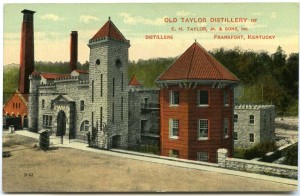By Richard Thomas
Come this summer, the whiskey news should be full of stories about the grand reopening of the Old Taylor Distillery, heretofore the prettiest distillery ruin in America, what with its fantasy castle facade and decadent, decayed gardens. If the restoration of a lovely old ruin into a functioning distillery.
If that weren’t enough, former Brown-Forman Master Taster Marianne Barnes is the steward of the shop, making her the first woman Master Distiller in Kentucky. That point has already received more press attention than the renovation of the distillery she will run. With all that potential hoopla waiting just four or five months down the road, a primer on Old Taylor is in order.
Edmunds Haynes Taylor, Jr.
The distillery is named for its founder, who happens to be that Taylor, as in Colonel E.H. Taylor, a pivotal figure in the American whiskey industry of the late 19th Century. With both James Madison and Zachary Taylor in his family tree, Taylor was born the son of a prominent Frankfort, Kentucky banker, and it was following in his father’s footsteps as a financier that he became a noted bourbon figure. Most of the historic names revered by modern bourbon enthusiasts were not chemists and distillers, but instead came from the business side of the picture, and Taylor was no exception.
After remodeling the O.F.C. Distillery that eventually became Buffalo Trace, Taylor moved on to the project that still bears his name today: the Old Taylor Distillery. Located on the banks of Glenn’s Creek (the same creek as Woodford Reserve), Taylor built the place in 1887 with an eye on making it a showcase for the Kentucky bourbon industry.
The main distillery was built with local limestone masonry as a faux castle, while the spring from which the distillery drew its water was enclosed in a neo-classical pergola supported by stone columns. The sprawling property once sported elegant gardens and fish ponds as well, and in its heyday must have conjured the fairy tale image of Southern genteelness.
Taylor himself passed away in 1922, aged 90. His distillery was acquired by National Distilleries in 1935, and then found it’s way into the hands of Jim Beam, who closed it in 1972 in response to the infamous 1970s bourbon slump.
Shuttered And Revived
The distillery ceased making new spirit in 1972, but it continued as a whiskey warehouse center for Jim Beam until at least the early 1990s. This is why what are now called urban explorers (such as myself) and juvenile delinquents would often encounter security guards upon approaching the abandoned distillery, because closed or not there were still rickhouses stuffed with bourbon there.
Later the Old Taylor Distillery was nearly lost to us, thanks to the housing boom of the early 2000s. In 2005, when the bubble was nearing its peak, a group of Atlanta investors bought Old Taylor with the intention of harvesting its rich architectural heritage for salvage. Some of the warehouses were pulled down for their masonry and pine timber, which was sold through Heart Pine Reserve, now defunct. The dismantling of the Taylor bourbon estate ground to a halt when the bubble burst and brought on the Great Recession.
One boom often gives way to another, however, and where real estate and home construction were all the rage in 2005, in 2015 it was the bourbon industry that was exploding. The property was purchased by a company called Peristyle in 2014, and despite the carping doubts of the croakers, renovation was well under way the next year.
With the new construction, the property also opened to storing barrels again. Their first customer was Barrell Bourbon, who put their barrels into the Old Taylor warehouses in Summer 2015. “I keep almost all of our barrels there,” said Barrell Bourbon owner Joe Beatrice.
Now the Old Taylor Distillery is now close to turning out its first new make in more than 30 years. When I contacted Old Taylor about arranging a visit in November 2015 (one I was regrettably unable to make), they forecasted being operational by Summer 2016.
 The Whiskey Reviewer A World of Whiskey, Poured Every Weekday
The Whiskey Reviewer A World of Whiskey, Poured Every Weekday

